Jain temples in Ahmedabad are not just destinations for worship, they are a profound testimony to glorious craftsmanship and the spiritual aspirations of a community that has thrived in the region for centuries. Each temple, with its distinctive architectural design, stands as a peaceful escape in the bustling city, complete with stunning spires that reach towards the heavens. Walking through these sacred spaces, one can’t help but notice the intricately designed motifs that adorn the walls, adding to the serene and venerable atmosphere.
History and Architecture of Jain Temples in Ahmedabad
The Jain temples in Ahmedabad are not just places of worship but also serve as exemplars of architectural brilliance. These sacred structures date back centuries and represent the rich cultural tapestry of the region punctuated by spiritual depth. Their architecture combines intricate carvings, ornate pillars, and fine craftsmanship that evoke the eras of peace and prosperity when they were constructed. Popular Jain shrines in Ahmedabad encapsulate the harmony of religion and aesthetics, making them an invaluable part of the city’s cultural heritage.
Reasons to Visit Popular Jain temples in Ahmedabad
| Reason | Details |
| Religious Importance | Jain Temples in Ahmedabad hold great religious significance, attracting devotees for their spiritual value and serene atmosphere. |
| Architectural Beauty | These temples are known for their intricate carvings, beautiful architecture, and historic value, making them a visual delight. |
| Cultural Heritage | Visiting Jain Temples in Ahmedabad offers a glimpse into the rich cultural heritage of Gujarat and Jain traditions, deeply embedded in the city’s history. |
| Peaceful Environment | The temples provide a tranquil environment for meditation and spiritual reflection, offering a break from the hustle and bustle of the city. |
Top 10 Famous Jain Temples in Ahmedabad
1. Hutheesing Jain Temple: A Marvel of Architecture and Peace

Hutheesing Jain Temple stands as a testament to the architectural prowess and serenity emblematic of Jain temples in Ahmedabad. Constructed with luminous white marble, this temple captures the spirit of peace through its majestic domes and meticulously carved pillars. Influenced by the architectural finesse of the Solanki dynasty, the temple’s design breathes through the works of Premchand Salat—a testament to the craftsmanship of the Sonpura and Salat communities. For visitors and devotees alike, Hutheesing Jain Temple not only offers a tranquil retreat but also a journey into the artistic heritage that defines Jain architecture, much like Ranakpur’s exquisite craftsmanship.
Here’s a table summarizing key details about the Hutheesing Jain Temple:
| Feature of Jain Temples in Ahmedabad | Details |
| Name | Hutheesing Jain Temple |
| Location | Ahmedabad, Gujarat, India |
| Built Year | 1848 |
| Commissioned By | Hutheesing family |
| Architectural Style | Jain architecture with intricate carvings and marble work |
| Primary Deity | Dharmanatha (15th Jain Tirthankara) |
| Material Used | White marble |
| Key Attractions | – Manastambha (Pillar of Honor) |
| – 52 smaller shrines inside the temple dedicated to various Tirthankaras | |
| Special Significance | Known for its peaceful ambiance and stunning craftsmanship, a major pilgrimage site for Jains |
| Visitor Information | Open to tourists and devotees; respectful attire and behavior are encouraged |
2. Shri Mahavir Swami Jain Temple: A Spiritual Oasis in the City
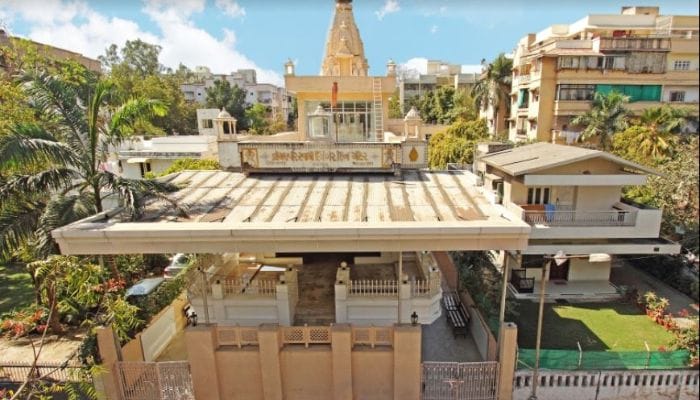 Image Source
Image SourceShri Mahavir Swami Jain Temple serves as a spiritual haven amidst the hustle and bustle of Ahmedabad. Recognized for its divine atmosphere, the temple reveres Lord Mahavir Swami, an important figure in Jainism. The temple’s traditional style, reminiscent of the ancient pathways of Jain worship, fosters meditation and reflection. Visitors often liken its tranquil environment to the solace found in Patan or Rani Ki Vav, blending spirituality with architectural grandeur.
Here’s a table summarizing key details about the Hutheesing Jain Temple:
| Feature | Details |
| Name | Shri Mahavir Swami Jain Temple |
| Location | Ahmedabad, Gujarat |
| Primary Deity | Lord Mahavir (24th Tirthankara) |
| Key Features | Beautifully crafted domes and sanctum |
Let me know if you need further edits!
3. Shri Vasupujya Swami Jain Temple: A Blend of Tradition and Serenity
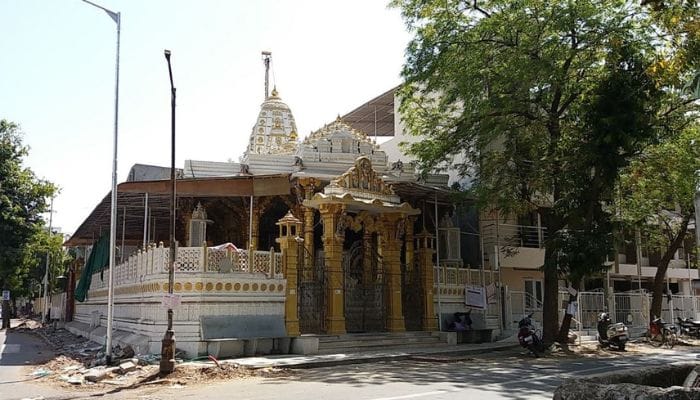 Image Source
Image SourceShri Vasupujya Swami Jain Temple is remarkable for integrating a profound sense of tranquility with enduring Jain traditions. Dedicated to Lord Vasupujya, the twelfth Tirthankara, it reflects the Digambar Jain Paramgam’s ethos. The temple’s ambiance and sanctum resonate with peace, providing pathways for meditative prayer. Adorned with murals and brackets showcasing Jain iconography, the temple stands as a serene escape amidst Ahmedabad’s vibrancy.
4. Derasar in Calico Mills: A Sanctum of Jain Heritage
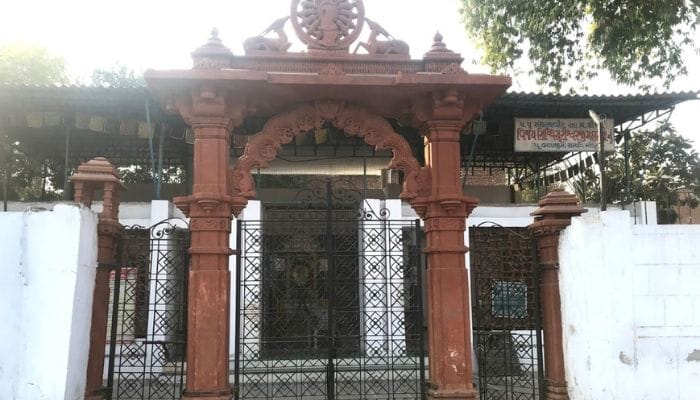 Image Source
Image SourceThe Derasar at Calico Mills is a sanctified repository of Jainism’s profound historical and cultural heritage. Nested within one of the city’s oldest textile hubs, this Derasar embodies spiritual identity amid industrial narratives. The temple resonates with the Jain ethos upheld by sects like Hwetambar Jain and Digambar, symbolizing unity amidst diversity. It also serves as a fascinating counterpoint to nearby Hindu palaces and patrician homes, enriching the exploration of Ahmedabad’s multifaceted cultural fabric.
5. Shri Simandhar Swami Jain Derasar: The Center of Enlightenment and Community
 Image Souce
Image SouceThe Shri Simandhar Swami Jain Derasar is a nexus for enlightenment and community bonding, revered for its embodiment of Lord Simandhar Swami’s teachings. Situated near the railway station in Mehsana, close to Ahmedabad, this temple is celebrated for its grand idol radiating calmness in the Padmasana posture. Known for its murals that depict the essence of Bhagwan Adishwar and Lord Simandhar Swami, the temple serves as a confluence for those exploring ancient Jain sites such as the Panchasara Parshwanath Jain Temple or Kothara in Abdasa.
6. Sambhavnath Jain Derasar: A Symbol of Devotion and History
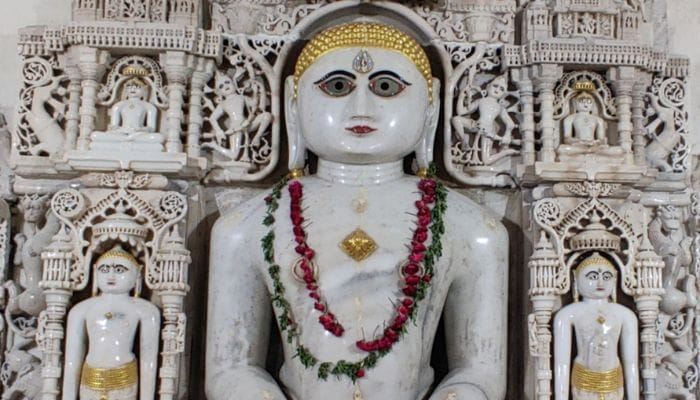 Image Source
Image SourceSambhavnath Jain Derasar stands as a profound emblem of devotion and a witness to centuries of history. Enshrining Lord Sambhavnath, the third Tirthankara, the temple’s elaborate carvings and sculptures resemble those of the Vardhman Shah Temple. Visitors can admire its artistry while tracing the Footprints of ancient sects and dynasties that shaped Ahmedabad’s spiritual legacy.
7. Chandraprabhu Swaminarayan Mandir: Where Ancient Rituals Meet Modern Faith
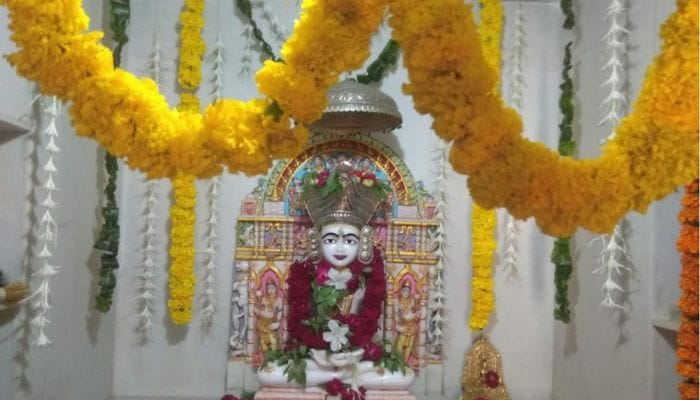 Image Source
Image SourceChandraprabhu Swaminarayan Mandir harmoniously intertwines ancient rituals with contemporary expressions of faith. Though relatively modern, its design borrows inspiration from the Jain temples in Ranakpur and the intricacies of murals seen in Patan. This temple celebrates traditional rites while embracing the needs of today’s spiritual seekers, creating pathways for devotion that appeal to both the devout and the curious.
8. Navkar Jain Derasar: A Contemporary Place of Worship and Reflection
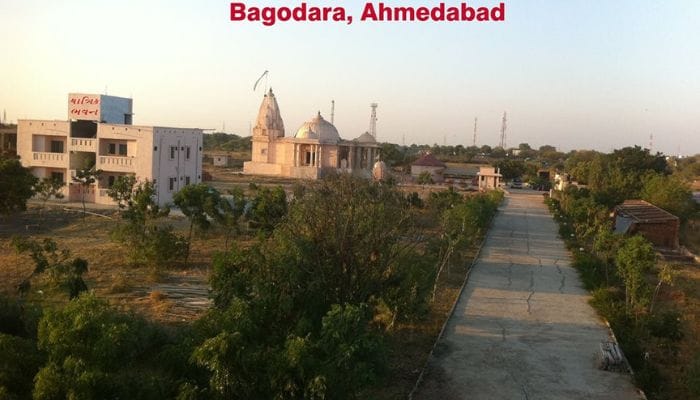 Image Source
Image SourceNavkar Jain Derasar represents a modern sanctuary where worship and introspection align in the contemporary sphere. Reverence for the Navkar Mantra resonates through its walls, echoing teachings from the Digambar Jain Paramgam. The temple blends tradition with modernity, standing as a counterpart to iconic structures like the Adinath Ji Temple, with its contemporary design supporting community gatherings and meditation.
9. Shantinath Jain Derasar: Preserving Centuries-Old Customs and Artistry
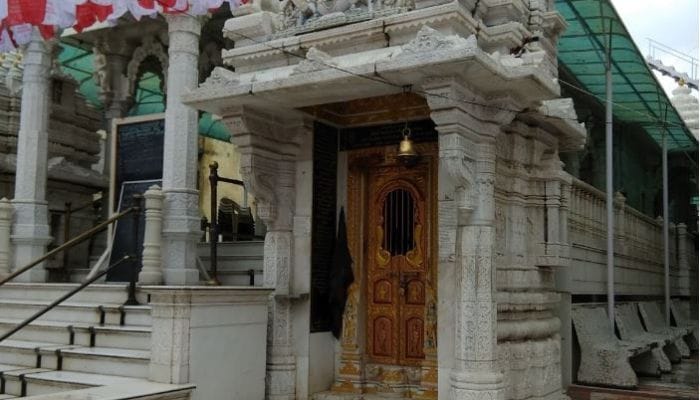 Image Source
Image SourceShantinath Jain Derasar is a custodian of antiquity, safeguarding customs and artistic expressions passed down through generations. Dedicated to Lord Shantinath, the sixteenth Tirthankara, its intricate carvings and sculptures resemble those found in historic temples like Kothara or Panchasara Parshwanath. The Derasar serves as a conduit between Ahmedabad’s urban development and its ancient Jain lineage, preserving its murals and heritage.
10. Shree Vardhman Sthanakvasi Jain Sangh: A Hub for Jain Philosophy and Education
 Image Source
Image SourceShree Vardhman Sthanakvasi Jain Sangh is recognized as a pivotal center for the propagation of Jain philosophy and education. This institution, much like Jain sites in Abdasa and Patan, integrates scholastic learning with spiritual practice. Visitors here engage with Jain teachings through texts like Digambar Jain Paramgam while exploring the principles of Bhagwan Adishwar and Adinath Ji. It is a beacon for intellectual and spiritual pursuits in Ahmedabad.
Hutheesing Jain Temple: A Marvel of Art and Devotion
Architectural Grandeur of Hutheesing Temple
The Hutheesing Jain Temple exemplifies architectural magnificence, a hallmark of the Jain community’s reverence for artistry and precision. Designed by the eminent architect Premchand Salat, the temple showcases a stunning dome supported by twelve ornate pillars, serving as the crowning glory of the Mandapa—an open hall leading to the sanctum sanctorum. Its two-tiered structure is encircled by a courtyard that hosts 52 intricately carved shrines, each an altar to various Tirthanakara figures.
Drawing inspiration from ancient temples like Bhadreshwar and Vasai Jain Temple, the Haveli-style architecture blends symmetry and stone carvings to create a visual poetry that enthralls visitors. The design reflects resilience and continuity, having withstood the test of time and natural calamities such as earthquakes. Additionally, elements such as the intricate statues and the temple’s alignment with panchmeru nandishwara principles further amplify its spiritual and artistic value, transforming it into a grand spectacle of devout craftsmanship.
Key Highlights of Hutheesing Temple’s Architectural Splendor
- Inspiration from Historic Temples: The Hutheesing Jain Temple draws architectural influences from iconic sites like Bhadreshwar and Vasai Jain Temple, embodying timeless Jain design principles.
- Resilient Architecture: Built with precision and artistry, the temple has endured natural challenges, including earthquakes, while preserving its grandeur and spiritual significance.
- Spiritual and Artistic Harmony: The alignment with panchmeru nandishwara principles and the inclusion of intricate statues highlight the temple’s blend of devotion and aesthetic brilliance.
The Spiritual and Cultural Significance of a Pilgrimage Site
As a pilgrimage site, the Hutheesing Jain Temple is more than a remarkable architectural landmark; it is a profound spiritual beacon hosting pilgrims seeking enlightenment and blessings. The temple’s sanctity is amplified during Paryushan, the most important Jain festival, when thousands of devotees engage in prayers, fasting, and reflection. Much like Songadh Tirtha or Amnagar, it serves as a cultural hub, embodying the cherished values of Jainism—non-violence, truth, and asceticism.
Its role extends beyond religious rites, showcasing a rich cultural heritage through festivals, rituals, and educational programs. Furthermore, the temple’s historical ties to the Sultanate era and its proximity to landmarks like the Bedi Gate and nearby forts add layers of historical and cultural significance, making it a pilgrimage site that transcends time.
Accommodation Near Jain Temples in Ahmedabad: Stay in Divine Proximity
For those wishing to remain in close proximity to the divine aura of Jain temples in Ahmedabad offers a range of accommodation options. Some of the preferred facilities include Kutchi Vishram Gruh (Shahibaug) and Ahmedabad Swaminarayan Gadi Sansthan Ashram, among others listed by YatraDham.Org. These accommodations are known for reasonable costs and apt amenities. They ensure pilgrims can reside within a sanctified environment while enjoying facilities such as pure vegetarian Jain meals. Staying near these temples also facilitates participation in early morning prayers and rituals, allowing a deeper spiritual connection. For those exploring multiple pilgrimage spots, proximity to sites like Bhadreshwar or Songadh Tirtha provides a seamless spiritual journey across Gujarat.
Dress Code and Etiquette: Respecting Religious Norms
Adherence to a specific dress code and etiquette is paramount when visiting Jain temples in Ahmedabad to maintain the sanctity and spiritual ambiance of these sites. Visitors should ensure that upper wear covers the shoulders, chest, navel, and upper arms, while lower wear extends below the knees. Quietude and decorum are essential, respecting the devotees and the deity ensconced within. Much like the traditions upheld in Vasai Jain Temple and other ancient sites, maintaining this respect allows visitors to experience the serene environment of the temples. Observing these norms fosters reverence for the Jain ethos, enhancing the spiritual depth of the pilgrimage experience.
Explore the Essence of Gujarat: Temples, Festivals, Wildlife, and More
Whether it’s exploring the historic Sabarmati Ashram, admiring the artistry of Rani Ki Vav, visiting the serene Jain temples in Ahmedabad, or shopping for traditional crafts, Gujarat has something for everyone. Plan your adventures with the guide at Things to Do in Gujarat.
Gujarat is a land of spiritual vibrancy, home to some of India’s most iconic temples like Dwarkadhish Temple, Somnath, and Palitana. Explore more about these divine destinations at Famous Temples in Gujarat, where faith meets history and architectural grandeur.
The festivals of Gujarat, like Navratri, Uttarayan, and the Rann Utsav, paint the state in hues of celebration, music, and dance. Immerse yourself in the cultural extravaganza by visiting Festivals in Gujarat for detailed insights.
From the Asiatic lions of Gir to the migratory birds of Nal Sarovar, Gujarat’s wildlife sanctuaries offer a thrilling encounter with nature. Dive into the wilderness at Wildlife Sanctuaries in Gujarat and discover the state’s natural treasures.
The traditional attire of Gujarat, like the vibrant chaniya choli and intricately embroidered kediyu, reflects the state’s rich cultural heritage. Learn more about these timeless styles at Traditional Dress of Gujarat.
Traveling with your furry friend? Ahmedabad offers numerous pet-friendly hotels ensuring a comfortable stay for both you and your pet. Explore the options at Pet-Friendly Hotels in Ahmedabad for a stress-free experience.
From thrilling rides to water park adventures, Ahmedabad’s theme parks are perfect for family fun and entertainment. Find the best places to visit at Theme Parks in Ahmedabad for an unforgettable day out.
FAQs about the Top 10 Famous Jain Temples in Ahmedabad
Which is the most famous Jain temple?
The most famous Jain temple in India is often considered to be the Palitana Temples, located on Shatrunjaya Hill in Gujarat, due to their religious significance and architectural splendor.
Which is the oldest Jain temple in Ahmedabad?
The oldest Jain temple in Ahmedabad is believed to be the Shantinath Jain Derasar, which dates back several centuries and is famed for its ancient artistry and architecture.
Which main Jain temples are located in Gujarat?
Key Jain temples in Gujarat include Palitana Temples on Shatrunjaya Hills, Girnar Temples in Junagadh, Hutheesing Jain Temple in Ahmedabad, and Taranga Jain Temple, among others.
Why should one visit Jain Temples in Ahmedabad?
Jain temples in Ahmedabad are not just religious landmarks but also architectural marvels. Visiting these temples offers a peaceful escape from the city’s hustle and bustle, while also providing a chance to witness intricate carvings and rich cultural heritage. They are perfect for anyone looking to experience the spiritual and artistic essence of Gujarat.
What is the best time to visit Jain temples in Ahmedabad?
The best time to visit Jain temples in Ahmedabad is during the cooler months from October to March to enjoy pleasant weather, and especially during the festival of Paryushan for a spiritually enriching experience.
Wrapping Up the Top 10 Famous Jain Temples in Ahmedabad, India
In conclusion, the top 10 famous Jain temples in Ahmedabad reflect a blend of spiritual sanctity, architectural grandeur, and a rich heritage that underpins the city’s cultural tapestry. Each temple, with its unique history and significance, offers pilgrims and visitors a chance to explore the ancient traditions and philosophical ethos of Jainism. These temples not only stand as sacred places of worship but also as repositories of ancient artisanship and cultural narratives. As you plan your spiritual journey through these divine edifices, remember to embrace the peace and wisdom they offer—a true reflection of Jainism’s timeless legacy.




